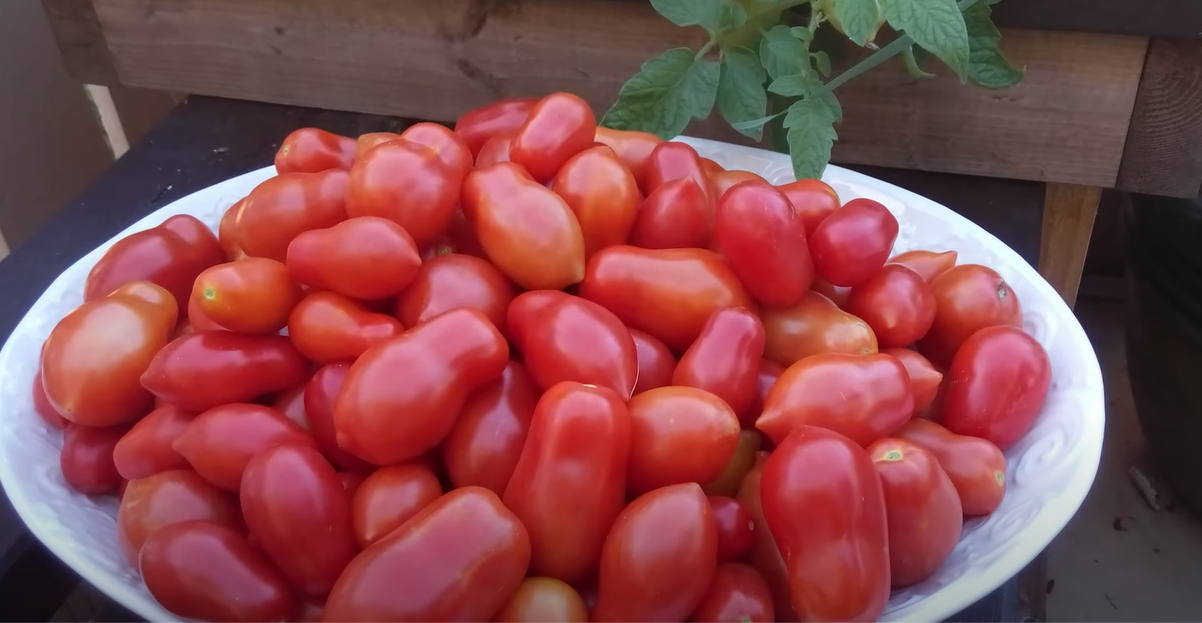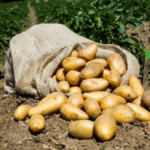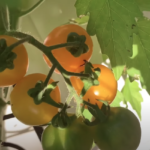Roma tomatoes are an American heirloom tomato cultivar, pear or plum shaped, sweet flavored with thick walls and best used for paste making, sauces, canning, ketchup and cooking. Larger than cherries and grapes in size, well known for having few seeds, Roma tomatoes ripen by turning fully red from bottom to top. They are a very productive paste-type tomato, making up for their small size by producing abundant fruit, which ripens all at once, on a single plant in a short time.
Table of Contents
Handy Tomato Kitchen Utensils
Here are some handy kitchen utensils for working with tomatoes of any kind including Romas (also see recipes section).
- Tomato strainer
- Tomato/Salsa Blender
- Food Processor for Tomatoes
- Tomato press
- Tomato mandoline for slicing
- Tomato slicer holder
- Heavy duty tomato slicer
- Tomato dicer
- Tomato corer
- Tomato jars for canning
- Tomato knife
- Tomato saver
- Countertop storage basket
- Tomato growing pots
What are Roma Tomatoes?
Roma tomatoes are a vegetable for nutritional purposes but botanically a fruit belonging to the plant species Solanum lycopersicum and nightshade family Solanaceae. Family membership includes well known vegetables such as eggplants, peppers and potatoes.
Roma is a determinate tomato which produces much fruit within a short period of time. Romas can also be grown as patio tomatoes. Furthermore, there are also purple Romas. Unlike indeterminate tomatoes, determinate tomato plants reach a certain height and terminally stop growing. Roma tomatoes are consumed at maturity and are considered ripe when the whole tomato turns red. Primarily used for certain culinary purposes, Roma tomatoes perform well in flavor when cooked and are not as flavorful when eaten raw (see recipes section)
Roma Tomato Origins
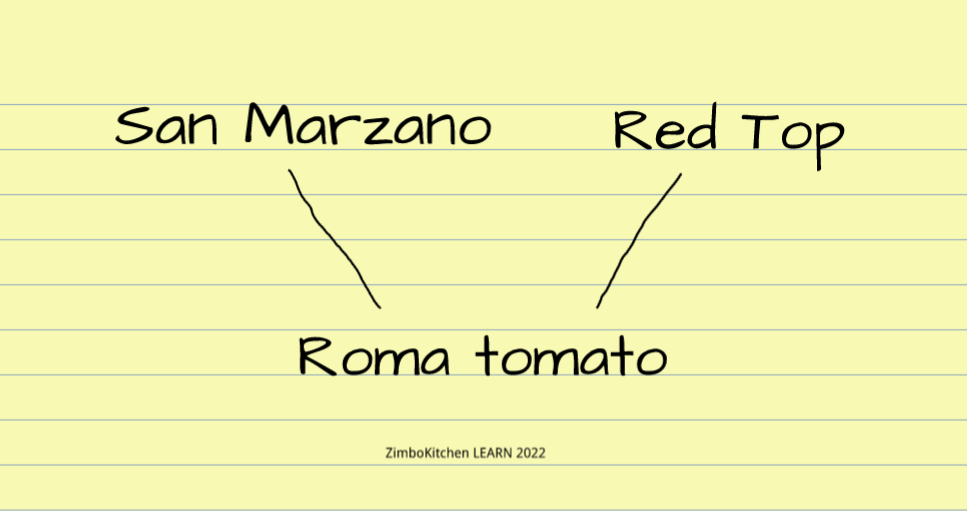
Sometimes called Italian tomato or Italian plum tomato, Roma tomato is actually an American tomato type that was developed in 1955 in Beltsville, MD by U.S Department of Agriculture’s Agricultural Research Service (ARS) scientist, William S. Porte.
The Roma was developed from San Marzano and Red Top tomato varieties (e.g. Pan America tomato which Porte also developed). The main objectives behind the type were disease resistance and good crop performance under different climates. However, the Roma is also a well respected paste-type tomato.
The official name of Roma tomato cultivar is Roma VF, which denotes its resistance to tomato wilt fungal diseases namely verticillium wilt and fusarium wilt. Consistent with the Porte’s objectives, today Romas are cultivated not only in the United States by all across the world.
Romas are an open-pollinated old tomato cultivar and considered an heirloom type on account of their long and enduring history. The cultivar is nearing 70 years old since its 1955 release.
Roma Tomato Characteristics
Unlike regular tomatoes which are round shaped, Roma tomatoes are a pear-shaped or plum-shaped fruit. The shape of the fruit is sometimes also described as oblong, deep round oval or egg-shaped. Roma tomato size is about 3 inches or 7.6 cm long. In addition, Romas have a firm thick fleshy wall, few seeds and lower water content.
Lower water content and thick, dense, grainy flesh makes the tomato best suited for making tomato paste and tomato sauces. Furthermore, the heavy, fleshy outer wall of the tomato makes it particularly ideal for sauces used in pizzas and spaghettis.
As for the plant, the Roma tomato plant is compact, grows in height to a certain level (determinate) and produces a burst of fruit which ripens about the same time. Early en masse ripening is one of the reasons Romas are a favorite for canning.
The following is a summary of Roma tomato characteristics.
| Cultivar name – Roma VF |
| Common name – Roma Tomato (American) |
| Botanical name – Solanum lycopersicum |
| Breeder – USDA ARS, William Solomon Porte |
| Type – Open-pollinated, heirloom |
| Release year – Maryland, 1955 |
| Shape – Pear-shaped, plum-shaped, oblong, round oval, egg-shaped |
| Fruit size – Small, circa 3 oz. or 85 grams, larger than cherry and grapes |
| Skin & flesh – Thick, red when ripe, grainy flesh, low water content |
| Top uses – Paste making, tomato sauce, canning |
| Plant type – Determinate |
| Disease resistance – Verticillium Wilt and Fusarium Wilt |
Roma Tomatoes vs Regular Tomatoes
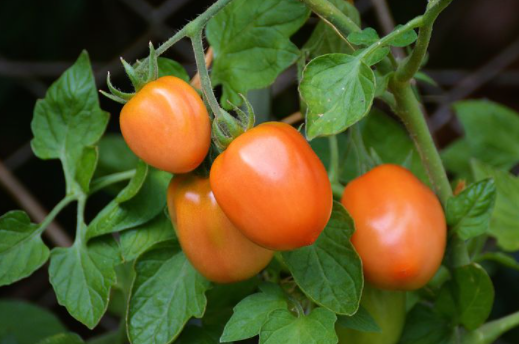
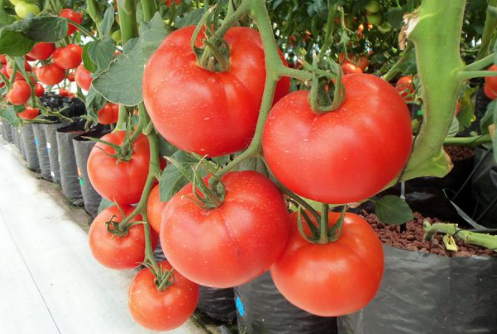
A comparison between Roma tomatoes and regular tomatoes reveals some major points of contrast. Regular tomatoes refers to globe type tomatoes which are standard tomatoes encompassing cultivars and varieties such as beefsteak (see Roma vs Beefsteak section) and other slicing tomatoes which are relatively large, round and red when ripe.
The first point of difference as already hinted is on shape and size. Roma tomatoes are smaller than regular tomatoes and are oblong with a near pointed bottom while regular tomatoes have near perfect round shape like an apple. In addition, regular tomatoes have much more seed than is found in Romas. Regular tomatoes also have much thinner walls than Roma tomatoes.
Whereas Romas have lower water content and are mostly used for pastes, sauces and canning, regular tomatoes are juicier and suitable for use in salads and on sandwiches as sliced tomatoes. Nonetheless, Romas can also work on sandwiches with some seasoning if one wants to avoid watery sandwiches, as happens with regular juicy tomatoes. In addition, regular tomatoes have traceable flavor when raw, the reason why they are used in salads and sandwiches. As for the Roma tomatoes, flavor is lacking when served uncooked.
Pertaining plant physiology, compared to most regular tomatoes, Romas are produced by determinate tomato plants whereas most regular tomato fruit is produced by indeterminate plants. Furthermore, unlike most regular tomatoes, Roma tomatoes maintain relative firmness when fully ripe. Round regular tomatoes tend to become extremely delicate and weak the more ripened they become.
Roma Tomato vs San Marzano Tomato

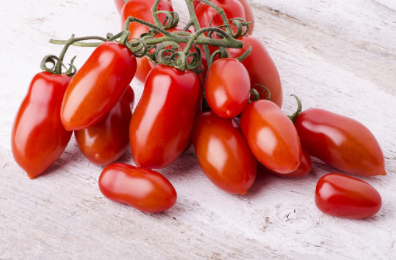
Juxtaposed, Roma tomatoes and San Marzano have more particulars in common than in difference. This makes sense because Romas got a genetic base from San Marzano. As earlier mentioned, Roma tomatoes are a cross between San Marzano and other varieties, some of which are descendants of San Marzano. Put simply, San Marzano genetics is written all over Roma tomatoes.
To begin with, both tomatoes are plum tomato varieties. They have an oblong shape with tiny points at the end although that of San Marzano is apparently more pronounced. They are both paste and canning tomatoes and are popular for this purpose.
In addition, they both enjoy similar culinary applications in cooking due to their low water content. We have in mind here pastas, pizzas, lasagnas and Mexican Chilaquiles rojos. When ripened, Romas and Sam Marzanos turn red with the latter turning somewhat deeper red. In broad terms, the two varieties show some enduring close but general resemblance.
Although Romas and San Marzanos have close genetics, there are also some important differences introduced by other varieties in the cross. For example, San Marzano tomatoes are longer in size, weigh more than the Roma tomatoes at about 110 grams or 3.9 oz. for an average tomato vs 3 oz. or 85 grams for an average Roma tomato. This is to say Romas turned out shorter, more stout and lighter in weight than their parent, the San Marzano.
Additionally, compared to Romas, San Marzano tomatoes have much thicker flesh, carry fewer seeds, have a more pronounced taste, are sweeter and less acidic than Roma tomatoes. They also seem better suited to eat raw than the Romas due to their flavor.
As far as plant physiology is concerned, there are also some differences between Roma tomatoes and San Marzano tomatoes. Romas are determinate plants while San Marzano tomato fruits are produced by an indeterminate plant. San Marzano is prone to the fungal disease, Fusarium Wilt. On the other hand, Roma tomatoes were bred to offer resistance to this very tomato malady.
Historically, San Marzano are specialty heirlooms from Italy. In fact, they take their name from a small town of San Marzano sul Sarno in Italy where they are produced under certain controlled conditions. In contrast, as discussed under the Roma origins section, Roma tomato is a product of breeding that took place in the United States nearly 70 years ago. As much time has passed, Romas are now also considered an heirloom cultivar in some circles although others do not consider them heirlooms.
Roma Tomatoes vs Beefsteak Tomatoes

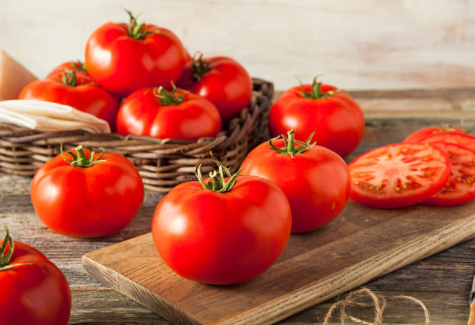
A comparison of Roma tomatoes vs beefsteak tomatoes reveals more differences than similarities between the two tomato cultivars. Although fully shared in the Solanum lycopersicum species, Roma and beefsteak tomatoes are distinctly different cultivars which ultimately shine differently in respective culinary applications.
However, both tomatoes are meaty. Just as the Roma tomato, beefsteaks have been used for canning, making purees and sauces. Their thick walls and ability to stay firm makes them equally suitable for canning. Additionally, both beefsteak and Roma produce low acid fruit which is welcome for individuals who particularly suffer with high acid content from tomatoes.
Nonetheless, whereas the Roma tomato is considered ripe when it has fully turned red, beefsteak tomatoes also turn red when ripe but also have a green cultivar known as the Green Beefsteak tomato. This particular beefsteak tomato is considered ripe and ready when fully green. Roma tomatoes have no similar cultivar that ripens whilst green.
Compared to Romas which are small, oblong, low water content tomatoes, beefsteaks range in size from medium to as big as 450 grams or more. Growers even enter competitions in raising giant beefsteak tomatoes.
Unlike Romas, beefsteaks have a round shape which in some cases mimics the roundness and shape of an apple. They have a high water content which makes them juicy tomatoes suitable for sandwiches and hamburgers. Beefsteaks look very attractive and appetizing when sliced up using a mandoline (example). In addition, beefsteak has been called the salsa tomato and the king of tomatoes.
Concerning plant physiology, beefsteak tomatoes are indeterminate tomatoes which require caging or trellising as support due to their prolific growth and vining. On the other hand, as already mentioned, Roma tomatoes are compact determinate tomatoes with a terminal height.
According to Purdue University Cooperative Extension Service out of Indiana, unlike Roma tomato, giant beefsteak tomatoes along with such other cultivars as Beefmaster, Ponderosa, and Oxheart which also produce large fruit, are more prone to diseases and skin cracking. Verticillium wilt and Fusarium wilt, which Romas are resistant to, are common diseases that plague beefsteak tomatoes.
While Romas originated through human action of cross breeding, apparently beefsteak tomatoes came to be through the mutation of a naturally existing cultivar. The origins of beefsteak tomatoes remained opaque and not clearly understood for decades until 2015. A report that appeared in 2015 showed that through identification of a certain set of genes, scientists were able to link beefsteaks back to Mexico from which they arrived in Europe in the 16th century.
All said and done, as has been shown in this comparison, Roma tomatoes are distinctly different from beefsteak tomatoes although both cultivars may share in certain culinary applications.
Roma Tomatoes vs Grape Tomatoes

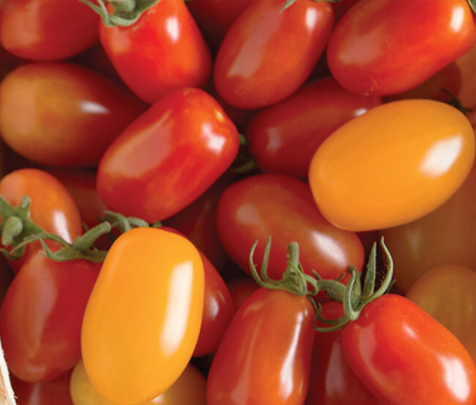
Contrasted, Roma tomatoes and Grape tomatoes are clearly two different tomato cultivars which may, however, have some similarities by virtue of being fruits of the same species. To begin with, although it is the red Grape tomato that is commonly known, Grape tomatoes come in a variety of shades namely pink, orange and yellow.
Whereas the Roma tomato is best suited for canning, making tomato paste, ketchup and produce flavor when instigated through cooking, Grape tomatoes have naturally occurring off-the-vine sweet to tangy taste and flavor. For this reason, Grape tomatoes are easily applicable in sandwiches and *leafy green* salads, for example. Being more versatile than Romas, they can also be roasted or grilled.
Nonetheless, Roma tomatoes and Grape tomatoes have some particulars in common. Both tomato fruits are meaty, not as watery as beefsteaks although the Grape tomato has thicker skin.
Put side by side, Grape tomatoes are much smaller in size than the Roma. They derive their name from the close resemblance with grapes, the fruit berries, in shape and size. An average Grape tomato fruit is 0.5 inches to 0.75 inches or 13 mm to 19 mm long compared to 3 inches or 76 mm for the Roma tomato. Furthermore, both Romas and Grape tomatoes have an oblong shape although Grape tomatoes are much shorter in length.
Concerning plant physiology, Grape tomatoes are indeterminate compared to Romas which are determinate tomato plants. Grape tomato plants are highly productive, producing fruit well even in hot conditions. In addition, as a vining plant, Grape tomatoes require staking, trellising or caging for support. They are a prolific plant which can grow as tall as 7 ft. or 2 meters tall. On the other hand, Roma tomato plants are compact and grow only as tall as 3 ft. or 1 meter in height.
In contrast to the Roma tomato, Grape tomatoes are prone to cracking especially after heavy rains or when watered following moisture stress. This is a common problem with cherry-like tomatoes such as the Grape tomato.
Historically, compared to the heirloom Roma tomato which was released in 1955, Grape tomatoes were introduced quite recently to the market in the 1990s. They are thus a relatively very young tomato cultivar when it is all said and done.
Purple Roma Tomato
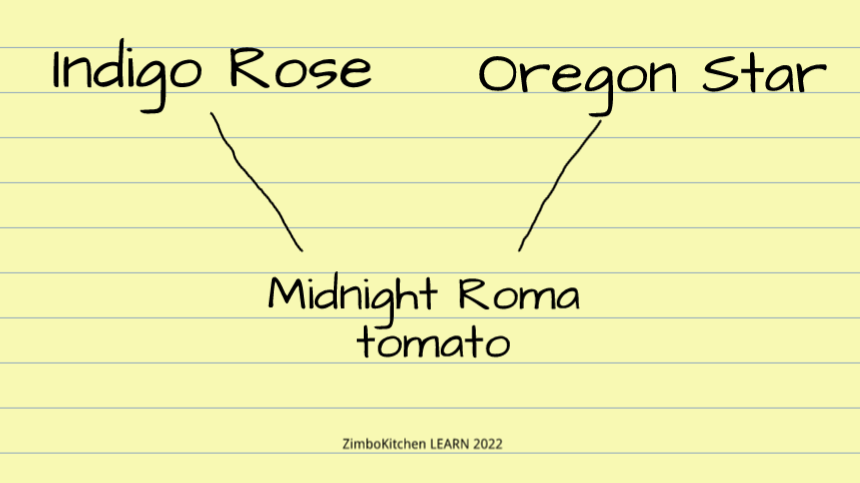
Purple Roma tomatoes are Roma tomatoes that ripen with a dark purple skin and flesh pigmentation. Roma purple tomatoes are best suited for just about the same applications as the regular red Roma tomatoes i.e. tomato paste making and cooking.
Purple Roma tomato cultivar represents one of the most significant developments that have occurred since the debut of the original Roma tomato in 1955. The Roma tomato has evolved into the purple Roma joining the ranks of other functional foods movements such as purple lettuce, purple broccoli, purple eggplants and blueberries.
Functional foods are fruits and vegetables that offer more than just nutrition but also superior health benefits such as cancer prevention, heart disease risk reduction, better immune system and so on. Functional foods such as those exemplified earlier with purple or black skin and flesh contain anthocyanins as source of the pigmentation and health benefits (see Roma benefits section).
The Purple Roma tomato is very rich in anthocyanins such that it is not only a fashionable tomato to eat but also a source of health benefits that go beyond just regular nutrition.
Midnight Roma Purple Tomato
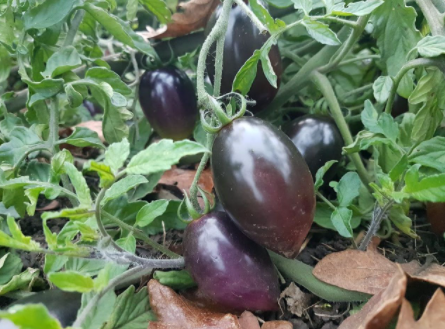
One of the most recently developed purple Romas is the Midnight Roma, a purple Roma tomato that was released in 2021. This paste-type tomato was developed by Jim Myers of the Oregon State University’s College of Agricultural Sciences.
This purple tomato cultivar was developed to be a processing tomato meaning to make tomato paste, tomato sauce and canning, for example. As a Roma, the tomato is also suitable for cooking. Similar to the regular red Roma tomato, the Midnight Roma has very thick walls and very few seeds. It is essentially different from other Romas on account of its dark skin as brought about by an intense presence of anthocyanins.
Midnight Roma is a crossbreed between two other varieties by the same University namely the Indigo Rose (seed supplier) and Oregon Star. Of these parents, the Indigo Rose (2011) is also a purple paste-type tomato while the Oregon Star which was released in 1992 is a regular red tomato.
The Midnight Roma purple tomato derives its fleshy, low seed production and big characteristics from the Oregon Star. Nonetheless, many people are often confused about how to tell when the purple Roma is ripe. According to Jim Myers, the “purple color goes from a shiny, dark black purple to more of a dull brownish purple when the fruit is ripe”
Roma Tomato Seeds
Roma tomato seeds are widely available in the United States and most countries around the world. Roma seeds germinate within 14 days after seeding and are ready for harvest within 70 days after transplanting.
The recommended planting depth of Roma seeds is 1/4 inch or 6mm with plant spacing of 24 to 36 inches or 60 to 90 cm. If planted in rows, the rows should be 36 inches or 90 cm apart.
Although many growers opt for commercially sold seeds, it is also possible to save Roma seed from existing Roma tomatoes as explained below.
Saving Roma Tomato Seed
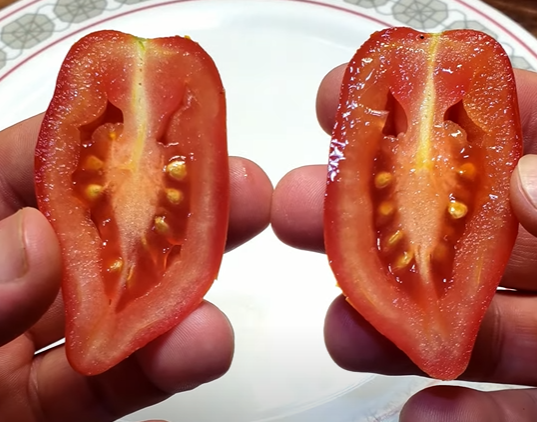
There can be as little as only 20 viable seeds in a large Roma fruit. As much as Roma tomatoes produce very little seed compared to many other tomato cultivars, it is still possible to successfully save seed from this tomato cultivar.
Seed can be saved from store bought heirloom Romas or those harvested from the previous season. The following are some steps to follow in harvesting Romas seeds from the fruit. You may need up to four or five Roma tomatoes to save a reasonable amount of seed in these steps.
| 1. Cut the tomato in two, longitudinally as shown in the image |
| 2. Core the seeds into a container using your fingers or a spoon. |
| 3. After collecting all the seeds you need, add water to the container with cored seed and inevitable tomato material |
| 4. Leave the seeds to sit in water for about two weeks. This allows fermentation to occur which breaks down the membrane surrounding each seed. |
| 5. After the fermentation occurs and the gel surrounding the seed breaks down, separate the seeds from the fermenting water by straining. |
| 6. Clean the remaining seeds by adding clean water to the container with the strained out seeds. Viable seeds will sink to the bottom of the container. |
| 7. Spread the collected Roma tomato seeds on a dry sheet of paper and leave them to dry, separating any seeds huddled together. |
| 8. Label and store the seeds in an envelope or zip lock bag. The Roma seeds can be stored for up to 5 years. |
We have been explaining the steps to saving dried Roma seeds above. However, it is also possible to propagate Roma tomatoes by simply burying a ripe tomato in garden soil. The other method is two squeeze Roma tomato juice into the soil including the seeds (important) before lightly covering with soil. These forgoing methods represent seeding fresh/wet tomato seed. take note that germination rate can easily become a lottery as some would simply rot and not come up.
Commercial Roma Tomato Seed
Planting Roma tomatoes from commercial seed is one way to ensure best quality and best germination rates compared to earlier discussed propagation options. The following are some North American commercial suppliers of Roma seeds. Some suppliers such as Gurney’s have available transplants, which cut back on the time to harvest compared to starting from seed.
- Roma tomato seeds via Amazon
- West Coast Seeds Roma tomato seeds
- Burpee Roma tomato seeds
- Gurney’s Roma tomato plants
- Johnny’s Paste tomato seeds
- Thompson & Morgan (UK) Roma VF seeds
- Baker Creek Roma tomato seeds
Roma Tomatoes Nutrition
Red Roma tomatoes are as nutritious as the many other varieties of red tomatoes. Among other nutrients, Romas offer potassium, vitamins B and E. According to Nutrionix, a nutrition database, a 62 grams serving of Roma tomato contains 11 calories. Of these, protein is 17%, carbs 75% and fat 8%. This same serving has potassium of 147g, vitamin A 10%, vitamin C 14%.
In addition, Romas and other red tomatoes get their red pigmentation from lycopene, a naturally occurring compound that also gives guavas, red oranges, watermelons, and pink grapefruit their color. According to a 2020 study published in the journal Antioxidants, lycopene is cardioprotective in humans. The pigment is said to have a protective effect against atherosclerosis and several cardiovascular diseases (CVDs). Atherosclerosis refers to the thickening or hardening of the arteries due to plaque build-up.
It can be stated that these functional health benefits are not exclusively linked to Roma tomatoes in of themselves but rather to lycopene which occurs in a variety of other fruits and vegetables. Nonetheless, eating Romas in particular is one way of ensuring lycopene intake. In any case, according to the journal Annual Review of Food Science and Technology , “processed tomato products are the primary dietary lycopene source in the United States”.
As earlier mentioned in this article, Roma tomatoes are paste-type tomatoes which are raised as processing tomatoes to make tomato products. This then suggests that dietary lycopene is obtained, to a significant extent, from Roma tomatoes in the United States.
A discussion on Roma tomato nutrition is incomplete without consideration of the emerging purple Roma tomatoes (see Purple Roma section). Purple Romas are recent and special Roma tomato cultivars which bring more than nutritional value to the table. As earlier stated purple Romas are rich in anthocyanins which happen to be a buzz word at present among eating healthy circles. Eating purple Romas gives a health promise which is more than just nutrition.
According to the Journal of Biomedicine and Biotechnology, anthocyanins are more than just colors but offer certain proven benefits. These include protection against liver injuries, high blood pressure reduction, eyesight improvement, anti-inflammatory benefits and suppression of the spread of cancer cells in humans.
Anthocyanins as found in purple Roma tomatoes are certainly more than a source of pigmentation in fruits and vegetables but of more important health benefits than just nutrition.
Roma Tomatoes Recipes
Although Romas are well known for their paste-type characteristics, they are very much used in a variety of other home recipes. One common home recipe that utilizes Romas is sauce making. Romas excel in making sauces thanks to their lower water content which ensures they thicken up much more quickly than over tomato cultivars which have more watery juice. In the event that it was needed, Roma tomato substitutes are any paste-type or plum tomatoes such as San Marzano.
The following are some inviting culinary recipes to try out made using Romas.
Roasted Roma Tomatoes Recipe
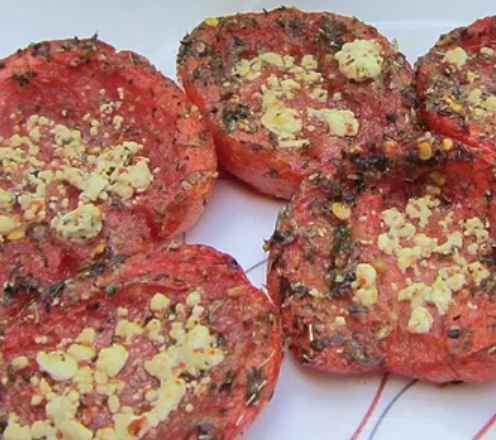
This simple recipe requires 8 Roma tomatoes which will be deseeded before use. Being Romas, deseeding is a small task here as the tomatoes have few seeds to start with. Although the tomatoes are assumed to be regular red Romas, this is also an opportunity to use purple Romas discussed earlier or a mix of both.
This is a herb rich recipe, such ingredients going in are fresh parsley, garlic, basil and oregano. The recipe takes 30 minutes total to make and serves 4. View Recipe.
Roasted Roma Tomato Sauce Recipe

This recipe produces fresh homemade scrumptious Roma tomato sauce. If you ever wanted to replace canned tomato puree or diced canned tomatoes with something more flavorful and fresh this is it. You could also use this recipe to make salsa for Mexican red Chilaquiles.
This recipe calls for 15 large Romas which are deseeded before use. Also in the ingredients list are fresh basil leaves and white onion. The tomatoes are first roasted for half an hour before they are blended using a good blender (example) or good food processor (example). The sauce is then simmered. This recipe produces 4 cups of tomato sauce and takes 40 minutes to complete. The sauce can be stored in the refrigerator for about a week after making it. View Recipe.
Classic Roma Tomato Cucumber Salad Recipe
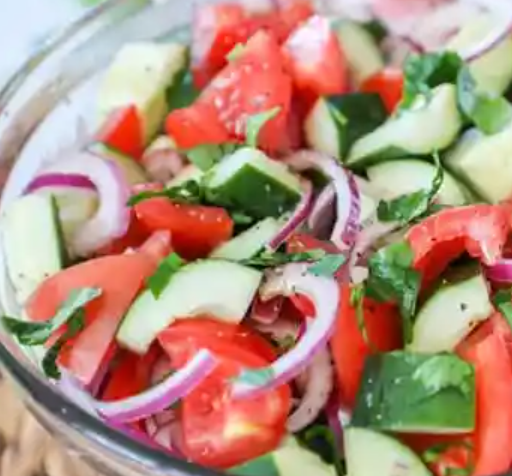
This recipe produces a delicious yet simple salad made with only three vegetable ingredients namely Roma tomatoes, English cucumber and red onion. If you wanted, you could also use Persian, Lemon or Armenian cucumber in place of the English cucumber. Just like English cucumbers, these other cucumber varieties would also work just as well in this recipe.
They are burpless cucumbers which are not bitter and have easily digestible thin skin. On the onion, you could also vary the recipe by using sweet onion such as Maui onion or Cipollini which could bring a pleasant sweet spin to things. Other ingredients in this recipe are pepper, extra virgin olive oil, red wine vinegar and salt. We must however point out that there has been debate whether it is a good idea to combine cucumber and tomatoes in a salad. There have been claims that this potentially works against the human digestive system. View Recipe.
Roasted Potatoes with Roma Tomatoes and Shallot Recipe
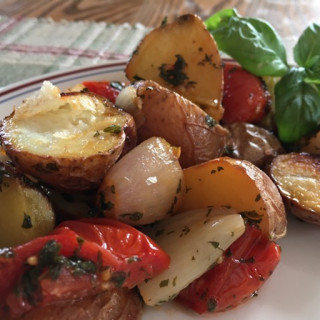
This recipe produces 4 servings and takes about 45 minutes to make. The potatoes are roasted with skin on. There is room to use Baby White potatoes here which have thin skin and are tender. You could also use any potato type but White potatoes such as Kennebec potatoes offer better nutritional value and are good for roasting too.
The other ingredients are of course shallots (example), extra virgin olive oil, parsley and black pepper to taste. The potatoes are put in the oven first and Roma tomatoes and the other ingredients are added after a time of roasting. View Recipe.
Sofrito Roma Tomato Paste Recipe
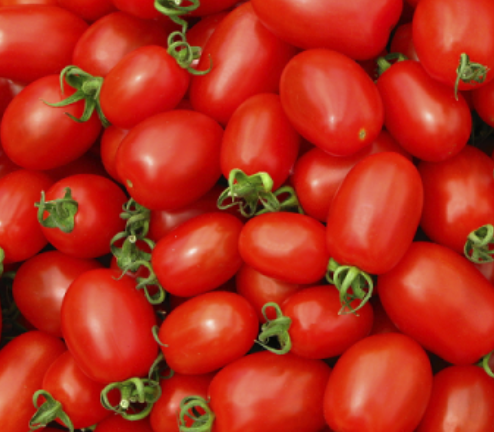
Sofrito is a thick savory tomato paste that is made out of tomato and other ingredients. This recipe by the Office of University Physician at Michigan State University demonstrates how to make a scrumptious tasting Sofrito. The recipe takes ripened Romas which are first blanched before use in the recipe.
Using the blanching method as explained in the recipe, the tomato skin simply slips off leaving the tomato flesh which will be diced. Other ingredients to be diced as well include peppers and onions before everything is combined into a saucepan to produce the paste. Sofrito can be used to season vegetables and pastas among other dishes. View Recipe.
Growing Roma Tomatoes
Romas like all tomatoes are sun lovers. They thrive when given maximum exposure to the sun of at least 6 hours per day. The tomatoes do well in well drained rich soils. For high germination rates, once the seeds have been sowed ensure that the soil remains moist until the seeds germinate.
Being a determinate plant with a limited height, Romas will generally not require trellising. However, the grower may decide to trellis or support the plant with a cage especially when laden with fruit. At this stage, there is risk of the stems breaking due to the combined weight of the fruit on the plant.
As earlier mentioned, Roma tomatoes were bred to be resistant to Verticillium Wilt and Fusarium Wilt. However, the tomato is still susceptible to other tomato diseases. Some growers have reported observing that the first set of Roma fruit to form suffers from blossom end rot. Subsequent fruits seem to do well.
There is certainly more to learn and appreciate about growing tomatoes in general. For this we recommend a guide, How to Grow Tomatoes, published by University of Illinois Extension.
Growing Roma Tomatoes in Pots
Growing tomatoes in containers is unlike raising them in the ground. There are certain requirements and approaches necessary when growing tomatoes in pots including Roma tomatoes themselves.
Growing Roma tomatoes in pots, in particular, is easy to do when the correct steps are followed. Romas are compact determinate tomato plants with a set height. This makes them manageable and therefore suitable for pot planting compared to vining indeterminate tomato plants.
Pot size for growing Roma tomato plant
To grow Romas in pots you will need a pot of at least 18 inches or 45 cm in diameter. The pot should also be between 14 inches to 20 inches or 36 cm to 51 cm deep but of minimum 12 inches or 30 cm deep whatever the case. The pot should have drainage holes to allow excess water to escape the pot and avoid water logging.
Also important to remember when growing Roma tomatoes in a pot is that this prescribed pot size is for one plant only. Planting one tomato plant per pot increases productivity by reducing competition for food between plants. This here is an example of a good pot size.
Preparing soil mix to put in Roma plant pot
Once the pot is in place next is the growing medium. If you have access to some, good old backyard crummy soil will work perfectly. The actual recommended soil mix for growing Roma tomatoes in pots is 60% crummy backyard soil, 20% peat moss and 20% compost. Backyard soil will bring the soil and some nutrients, peat moss will contribute organic matter whilst the compost portion will contribute some organic matter plus micronutrients.
Commercially available top soil (example) can be used to replace crummy backyard soil whilst dehydrated cow manure (example) can be used to replace compost. Peat moss is also available commercially to purchase (example). Once the soil mix is prepared, the pot is filled leaving 2 to 3 inches or 5 to 8 cm from the top.
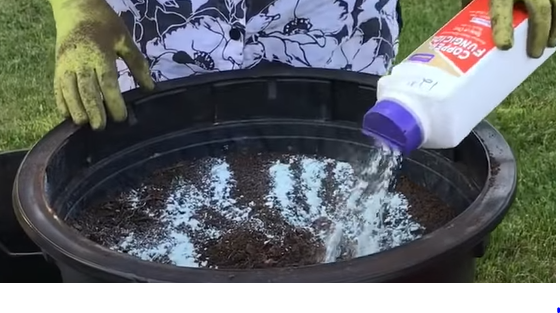
One more step to take before planting the tomato in the pot is to take preemptive measures against the full range of fungal blight tomato disease. Dust the top of the soil with copper fungicide.
This is an example of the recommended dust version and an example of the liquid version. Application of the fungicide to the pot before planting in this manner largely applies to growers in the Mid-Atlantic and Northeastern United States regions where there have been problems with early blight, mid-season blight as well as late blight fungal disease.
Planting Roma tomato in the pot
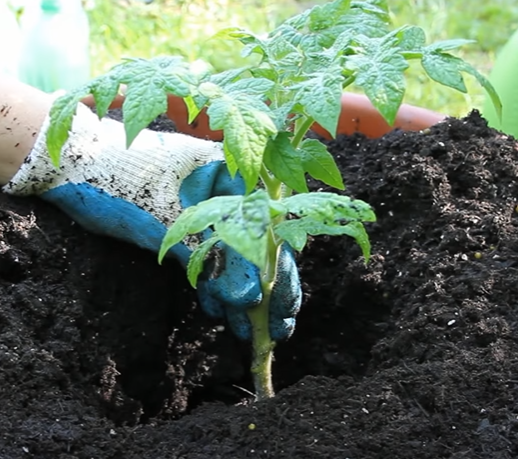
The final step to get Roma tomatoes growing in pots is the actual planting. Transplants will be used to start the plant in the pot. Dig a hole in the soil. The hole should be deep enough to accommodate the stem up to about the three last leaves. This depth will anchor the tomato plant securely in the pot.
After the planting, the next step is to sprinkle a 1/4 cup of some bone meal (example) around the plant. Bone meal is an efficient and reliable source of calcium. Tomatoes particularly need calcium to prevent blossom end rot, a plant physiological problem caused by calcium deficiency. After bone meal application, the plant can then be watered.
Care and maintenance
Growing Roma tomatoes in pots calls for ongoing maintenance of the plant. Two weeks after planting, a second application of the same amount of bone meal is repeated. A further two weeks later, a third application of a similar quantity of bone meal is again repeated. This is an important care and maintenance procedure done to replenish the calcium lost through leaching which is common when growing plants in containers.
Furthermore, every two weeks when the Roma tomato plant is not being fed bone meal, the plant is fed with Espoma Tomato-tone (example) a highly recommended tomato and vegetable food. Espoma is applied at about 1/4 cup and for at least six applications every two weeks until the plant gets to mature fruit.
Trellising Roma tomatoes growing in pots
As earlier stated in this article, Romas are determinate plants which generally do not need any trellising. However, when especially grown in pots, Roma tomato plants will require some support. This is mainly the case at the stage when they are laden with fruit. The fruit weight can damage plant stems.
For this reason it is advised to secure the plant to a cage, trellis or stake just for support. This support is much easier to manage as the height of the plant is manageable and also the plant itself does not vine out of control as is the case with indeterminate tomato cultivars.
Conclusion
Roma tomatoes are a paste-type tomato that was developed in the United States. The tomato is used to make paste, sauces and also for canning. Although it started off red, today there are purple or black Roma tomatoes which are rich in antioxidants. These antioxidants make purple Romas of a superior nutritional value than regular Romas and regular red tomatoes.
The Roma tomato has similarities and differences when compared to other well known red tomatoes. This is what makes it suitable for use in certain applications better than other known tomato cultivars. As far as cultivation is concerned, Roma tomatoes have specific disease resistance which is not found in other tomato cultivars. Furthermore, their ability to adapt to growing almost anywhere including in pots have made it a very popular tomato type to grow across the world and not only in the United States.
Random But Good Reads:
